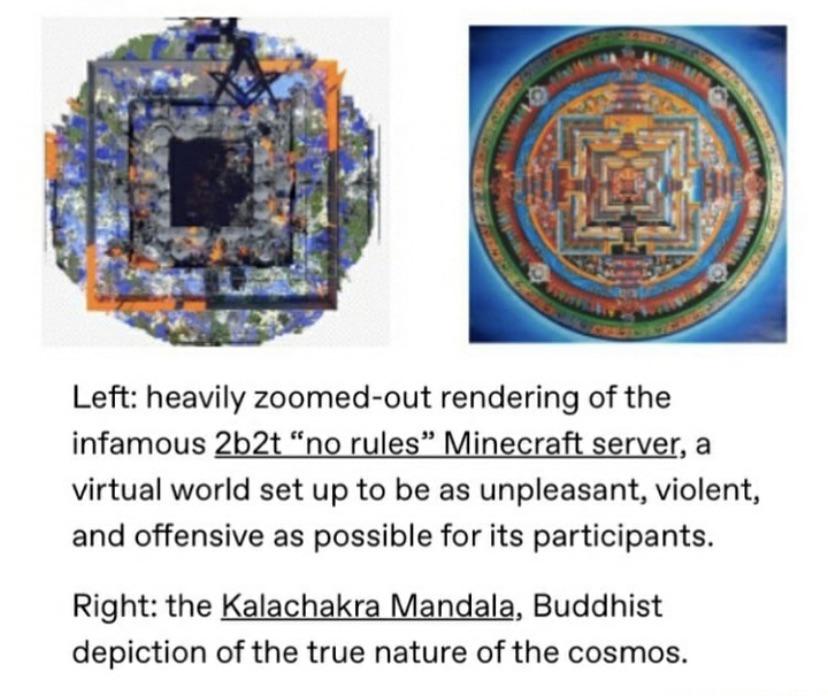
Sand Mandalas for the Modern Age
This blog post is part of the Agora Road Travelogue for June 2025
What is the World? The great realization among some of the Indian religions is that the perceptible world is but an illusion. Outside of the Platonic cave there is nothing. This is is all there is. This eternal cycle of death and rebirth where we take the eternal nap in one illusion of reality just to wake up in another is what is known as samsara. To escape this loop, to return to nothingness, is the ultimate goal of Buddhism.
Among the different manifestations of Buddhism (which are as varied as the different sects of Christianity) one of them has developed this tradition of creating mandalas (or representations of the World) made of sand. The process is painstakingly complicated, meticulously planned, and takes days or weeks to complete. The final product, which by itself could be revered as an idol by the more impressionable of individuals, is then destroyed, eliminated, obliterated; this, to symbolize the impermanence of things. “Nothing lasts forever”, as Pim from Smiling Friends would say.
The first time I explored such a concept was way before I had any understanding of the philosophical precepts of Buddhism, on the Internet, go figure. It was a video on YouTube, playfully titled “PikoPikoMaze!!” and was made by the user nana825763, infamous for having created the “Username 666” video. Back then I was scared shitless by the mere mention of his username, but I’ve grown to appreciate the work he makes, some of which I would call masterpieces. The video is a timelapse of him drawing a giant maze on a piece of paper. The video itself has an hypnotic quality to it, such that I watched it until the end. That’s when the good part comes in. At the end of the video, the maze that took days to be drawn is burned. The cheery music that plays in the background suggest that this was not done out of a sheer sense of edginess, but rather as a natural consequence of the process of drawing the maze. And, whether we like it or not, whether we are alive to witness it or not, truth is that is the ultimate end of all things. The paper maze would eventually rot away, return to nature; its components would sparse back to dust.
“Well, at least there’s a YouTube video about it!” You might say. And that might bring some comfort to us, who continually resist the idea of ephemerality. YouTube has been going on for like forever it seems. And that might trick us to believe that it will keep on going ad aeternum, sempiternal like the gods of the Greeks. It is, thus, easy to forget that the Internet is nothing but computers somewhere in the world, and that all things come to an end. The Internet is too young to notice, but eventually every page will too disappear. I came upon that conclusion when I realized that, after I die, when my credit card can no longer process payments, this very same website will be put to sleep; its servers rented to someone else (that is, if DigitalOcean still exists by then) and all its contents erased from the Internet.
At first I was scared by this. I, a data hoarder after all, pride myself in the redundancy that I implement to the data I collect. The only department I’m lacking as of now is that of georedundancy, or the capacity of having backups of data in different locations. The thought of my webpage disappearing was unbearable, to the point that I was thinking of building my own server to host it. Yet, that setup would still require for someone to pay for the electricity and the Internet connection. “Is there anyone else who thinks about this?” I wondered.
Enter TikTok. I’ve called it the social media with the best algorithm. Within just a couple of swipes you are well within your comfort zone. However, my OCD kicked in again and I was thinking of ways in which to backup every video I liked. It was then that I noticed most creators on TikTok, opposed as something as YouTube, have no permanence on their minds at the time of creating content. They would upload tons of videos which are essentially the same, just with slight variations, in the hopes that some of them go viral or appeal to their userbase. They will follow and forget trends as needed. There was no point in backing up these videos. They weren’t made to be revered as pieces of what might some day become lost media. They were made to be ephemeral, to be a “just once” thing. That’s the concept of ma (間) that I recently learned, where else, on TikTok; the notion that there are things that pass by around us. Blink and you’ll miss it. Life is now, and won’t last forever, so you might as well enjoy the little things even if they are not meant to last.